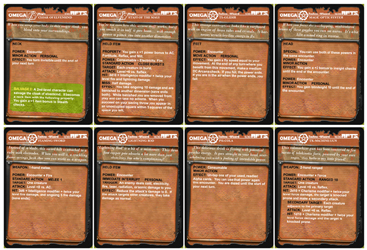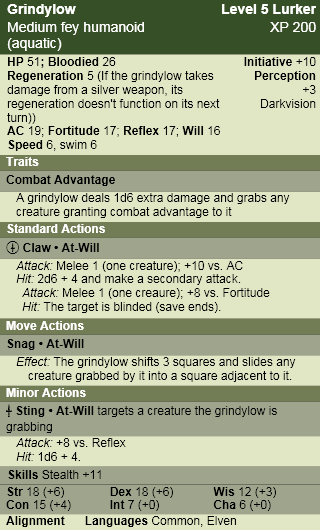Posts Tagged ‘Gamma World’
Random Encounters: The Splugorth in Gamma Rifts
April 28, 2011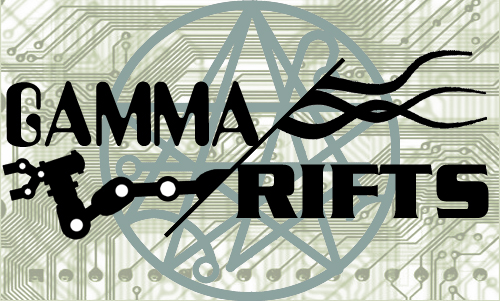 While Techno-Wizardry may be the quintessential theme of Rifts, the Splugorth are the setting’s quintessential villains. Atlantis, as presented in World Book Two: Atlantis, took all the new age influences on the game (ley lines, crystal magic, pyramid power), and brought them together in the most unexpectedly sinister of places – the lost continent. Atlantis is the dark and frightening Mordor (or underdark) of Rifts Earth. It’s a place where the bad guys won and heroes soil their power armour just thinking about (since, as presented in the book, it was pretty much instant death if you actually went there). This is what made the book great, not that it was really useful as a supplement for adventuring in Atlantis (it really only provided the briefest of sketches of the key locations – about ten pages), but it made Atlantis scary enough that should the PCs encounter the minions of the Splugorth (who are detailed in the rest of the page count), it gave them the kind of gravitas GMs strive to imbue their villains with. Plus tattoo magic was badass.
While Techno-Wizardry may be the quintessential theme of Rifts, the Splugorth are the setting’s quintessential villains. Atlantis, as presented in World Book Two: Atlantis, took all the new age influences on the game (ley lines, crystal magic, pyramid power), and brought them together in the most unexpectedly sinister of places – the lost continent. Atlantis is the dark and frightening Mordor (or underdark) of Rifts Earth. It’s a place where the bad guys won and heroes soil their power armour just thinking about (since, as presented in the book, it was pretty much instant death if you actually went there). This is what made the book great, not that it was really useful as a supplement for adventuring in Atlantis (it really only provided the briefest of sketches of the key locations – about ten pages), but it made Atlantis scary enough that should the PCs encounter the minions of the Splugorth (who are detailed in the rest of the page count), it gave them the kind of gravitas GMs strive to imbue their villains with. Plus tattoo magic was badass.
The Splugorth specialized in Bio-Wizardry and Rune Magic, which would either warp the bodies and minds of their slaves into useful tools or bind their souls to power impressive magical weapons. Boy were the items impressive. They also had price tags that prohibited players from getting their hands on them. Back in the nineties, we would dream about the kind of mayhem we could wreak, if only we managed to somehow find a sword of Atlantis. Rather than question the wisdom of the sheer volume of these kinds of weapons in World Book Two, I had a great time stealing them for this last instalment of 10 Omega Tech cards in my ongoing series on using Gamma World in Rifts (just click on the picture at the end of the post for the PDF – I’ve combined whole set of 30 cards for ease of printing). I’ve mentioned before about the beauty of Omega Tech cards as treasure, and I have to say it felt liberating throwing these iconic items into the deck – items I had always thought were cool but had never seen in actual play because they were too crazy (well, we did see zombitrons and magic talismans get used, but never any of the rune weapons).
I followed the pattern set in the Magic and Techno-Wizard cards and included two salvageable items. This time a one-handed ranged weapon and a two-handed melee weapon (I was thinking of making the magic talisman salvageable, but the weapons from Atlantis are so much more interesting than the defensive items).
One of the charms of the Bio-Wizard symbiotes and parasites from Rifts is that they are often as harmful as they are helpful. It added to the whole intimidation factor of the Splugorth, and I wanted to preserve that feel when it came to their Omega Tech cards. Luckily, a quick flip through the Omega Tech that came with my Gamma World boxed set revealed the blueprint I was looking for: many of the cards had some negative effect (usually another attack targeting the user or her allies) on a miss. This mechanic lets the cards be attractive enough to use, but dangerous enough not to be taken lightly. Just the kind of thing Lord Splynncryth would find amusing.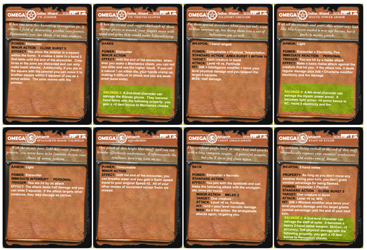
A final word (rant), about the Splugorth. I never really liked the portrayal of Splynncryth in the Rifts books beyond World Book Two. I felt they played up the ‘used car salesman’ aspect of its personality, making Splynncryth seem more human in its motivations and less like an otherworldly, alien monstrosity. Sure there’s a bit of that there in World Book Two, but Siembieda never lets you forget that this thing is the spawn of the Lovecraftian Great Old Ones, extracting decadent and weird pleasures from the torture, humiliation and annihilation of entire worlds. That’s the kind of villain the PCs can dedicate their lives trying to fight.
Random Encounters: Techno-Wizardry in Gamma Rifts
March 10, 2011 Techno-Wizardry is the hallmark of the Rifts game, epitomizing the setting’s mixture of high-tech and high fantasy like nothing else. There were other ‘kitchen sink’ settings that combined elements of science fiction and fantasy (as early as 1977 Dave Hargrave introduced the Techno class in the Arduin Grimoire), but Rifts was the first game that I ever played where they were so thoroughly blended.
Techno-Wizardry is the hallmark of the Rifts game, epitomizing the setting’s mixture of high-tech and high fantasy like nothing else. There were other ‘kitchen sink’ settings that combined elements of science fiction and fantasy (as early as 1977 Dave Hargrave introduced the Techno class in the Arduin Grimoire), but Rifts was the first game that I ever played where they were so thoroughly blended.
When my friends and I played Rifts in high school, we were fascinated with the concept of Techno-Wizardry, especially the rules for modifying and creating your own items (unfortunately, all we ever added to our vehicles were spoilers and bitchin’ flames on the side – we failed most of our rolls to add anything useful – go figure). Later, when I had grown dissatisfied with the system and 3e D&D came along, the clean item creation rules were something I appreciated. The Gamma World rules don’t support creating your own items (I think having to fix a vehicle or pilot a giant robot would make an awesome skill challenge), but the Omega cards are the next best thing (and some are salvageable – which simulates item creation).
Continuing from my previous post on Omega Tech cards for a ‘Gamma Rifts’ game, I present the next 10 cards in the set of 30: the Techno-Wizard origin (just click on the picture at the bottom of the post for the full PDF). To make it easier to print out with the last 10 cards (the Magic origin), I’ve just added these to a single PDF.
I followed the same pattern as with the Magic origin cards, including 2 salvageable items, but I made sure that they occupied different item slots so there wasn’t overlap (so now we have a neck, weapon, hands, and armor item in total).
Like the last set, many of the Techno-Wizard items had a suite of powers, so I tried to distill them down to their bare essence. I also had a hard time finding consumable TW items other than psi-cola, so I created the teleport grenades out of whole cloth (grenades seem popular in the Omega cards).
One final word on Techno-Wizardry. I’d be remiss if I didn’t mention Dr. Doom from Marvel comics (he is the namesake of my handle and one of the greatest villains of all time), the original Techno-Wizard. From his first appearance in Fantastic Four #5 (1962), he has always been depicted as using black magic and super science hand in hand. Given the popularity of the comic, and that it predates OD&D by nearly a decade, I’ve always wondered if the character was one of the influences on the proliferation of genre crossover in early D&D products (especially in early 3rd party books). Kevin Siembieda did work on those early Judges Guild products… who knows what the connection is (maybe Rifts was just tapping into that vibe he saw in the early RPG field)? My love of Doctor Doom tempted me to include one or two of his signature items in the set, as a tribute to the grandfather of Techno-Wizardry, but I figured I’d save it. Maybe after I finish this set of Rifts Omega cards I’ll make a small set of Marvel inspired ones (given that I’ve already mentioned my previous Rifts game included Captain America’s shield, there’s a pretty good chance of this happening).
Soon to come: the final installment of Gamma Rifts Omega Tech, Splugorth items!
Random Encounters: More Gamma Rifts
February 9, 2011 As I mentioned in my previous post, the final ingredient needed to capture the feel of Rifts earth in the Gamma World game are some magically oriented Omega Tech cards. I figured a set of 30 cards would complement the set of 40 that come with the Gamma World box and duplicate the same mix of magic and technology the ‘average’ party of adventurers in Rifts were equipped with (the mechanics of the cards have the added benefit of giving every character ‘class’ the opportunity to play with everyone else’s toys without breaking the game – meaning a robot can use a TK-machine gun and a dragon can get a cybernetic implant).
As I mentioned in my previous post, the final ingredient needed to capture the feel of Rifts earth in the Gamma World game are some magically oriented Omega Tech cards. I figured a set of 30 cards would complement the set of 40 that come with the Gamma World box and duplicate the same mix of magic and technology the ‘average’ party of adventurers in Rifts were equipped with (the mechanics of the cards have the added benefit of giving every character ‘class’ the opportunity to play with everyone else’s toys without breaking the game – meaning a robot can use a TK-machine gun and a dragon can get a cybernetic implant).
I divided the cards into 3 origins (mirroring Gamma World’s), magic, techno-wizard, and splugorth, with 10 cards each. The original cards have a salvageable card about every fifth card, so I gave each origin 2.
Presented here are the first 10 cards of the set, the magic origin (click on the picture for the full file): Bag of Holding, Boots of Speed, Counterfeit Mjolnir, Potion of Heroism, Daern’s Instant Fortress, Cube of Force, Vorpal Sword, Portable Hole, Cloak of Elvenkind, and Staff of the Magi. As you can see, these items aren’t actually from the Palladium world, but from D&D instead. I wanted to have one of the origins be made of ‘pure’ magic items, and so I went to the Palladium Fantasy game as a source first (since this is the source of these kinds of magic items in Rifts), but honestly I found most of the items were knock-offs of D&D treasures anyway. So I decided to use some of the classic magic items from the history of D&D, tempered by what I thought was cool (mjolnir) and what I needed to round out the cards (potion of heroism) – with a little help from the list in Paizo’s Classic Treasures Revisited. 
The great thing about the impermanency of the Omega Tech cards is that you don’t have to worry about slowly building the party up before you can give them something cool and sexy like a Daern’s instant fortress or a vorpal sword. There’s no need for an endless stream of meat and potatoes magic items (like +1 swords) – you can head right for dessert without fear of a stomach ache (I also think this approach fits very nicely with the world of Rifts, where nothing is meat and potatoes and everything is a soul-drinking greater rune weapon).
Keep in mind that I didn’t do direct translations of these magic items, the format of the Omega Tech cards wouldn’t allow it (some of the originals of these items had suites of powers – while Omega Tech cards generally only do one thing). Instead, I focused on the general concept of each item, and in some cases gave it a Gamma World-esque twist. For example, with the bag of holding, carrying around tons of treasure isn’t an issue in the game, so I instead focused on the quirky dimensional rift aspect of the item. With the staff of the magi I thought it would be funny to make it a disposable item (with the conceit that the characters can’t figure out how to use its laundry list of powers), so I focused on the aspect that first comes to mind when you think about the iconic staff: the retributive strike.
Soon to come: the techno-wizard and splugorth items!
Random Encounters: Grindylow
January 18, 2011So at the suggestion of KaosEleQtric regarding my retrospective on Rifts, I’ve converted the grindylow to 4e D&D stats. The exercise reminded me of two things. First, just how much mileage you can get out of a random generator. If you’re stuck for an idea of a challenge to face your players it is definitely worth checking out the multitude of random generators online (if only for a thought experiment to get the juices flowing).
The second thing I was reminded of was just how great 4e handles monster creation. Don’t get me wrong, the system has its flaws, but when it comes to making new monsters its king (and I ‘m in love with the monster builder in the adventure tools). I really like the approach the rules foster to monster creation. You tackle the design from the perspective of what you want the monster to do, first and foremost (i.e. shoot eye beams, fly around, or in the case of the grindylow blind people, drag them into the water and sting them), and the end result is a monster that mechanically fulfills that vision. I love that goblins, kobolds, and orcs all feel different in combat because they are mechanically different from one another (now I just wish that the classes in 4e felt a little more different from one another). Could 3e handle any of the monsters I’ve created on this site? Of course it could, I just think it’s a lot easier in 4e (now when it comes to customizing already existing monsters 3e is definitely the king – I love the idea of adding class levels and advancing venerable monster specimens in size).
‘m in love with the monster builder in the adventure tools). I really like the approach the rules foster to monster creation. You tackle the design from the perspective of what you want the monster to do, first and foremost (i.e. shoot eye beams, fly around, or in the case of the grindylow blind people, drag them into the water and sting them), and the end result is a monster that mechanically fulfills that vision. I love that goblins, kobolds, and orcs all feel different in combat because they are mechanically different from one another (now I just wish that the classes in 4e felt a little more different from one another). Could 3e handle any of the monsters I’ve created on this site? Of course it could, I just think it’s a lot easier in 4e (now when it comes to customizing already existing monsters 3e is definitely the king – I love the idea of adding class levels and advancing venerable monster specimens in size).
With all the rumors of 5e floating around (which I think are premature personally), lets hope D&D keeps this approach to monster design.
The Grindylow
“When I was a lad my grandmother used to warn me away from the twisty bog, for that was the home of the grindylow. When I had seen my fifteenth winter I ignored her tales, as young men are wont to do, and set off into the bog with a group of ruffians in search of gold and adventure. Nary a one of them survived, all dragged beneath those black waters by the thing’s long, cruel claws, its tail cracking like a horseman’s whip. The grindylow had found us, and I’ll never forget that crying, screaming little boy I saw reflected in those hateful eyes.”
Lore
Arcana DC 15: Grindylow are malevolent fey that live in noisome bogs and other still bodies of water. They prefer to drown their prey, but are just as capable out of the water.
Arcana DC 20: The touch of pure silver burns the grindylow’s corrupt flesh, preventing it from healing. The creature’s magic aura befouls any water it stays in, earning the grindylow the enmity of Nymphs and Druids.
The Grindylow in combat
Grindylow tend to focus on weaker targets who they can easily blind and drag back to the water. They are slow witted creatures driven by an unceasing hunger for humanoid flesh and are incapable of formulating complex plans on their own.
Encounters
Grindylow are usually too cowardly to tackle a group of well armed heroes on their own, but are often pressed into service by smarter and more powerful creatures like bog and river hags. Grindylow like to hide at the fringes of combat, waiting for an opportunity to grab the wounded and drag them away from their allies.
Notes
If you’re going to use the grindylow in Gamma World add the extradimensional keyword to the monster’s description.
I ended up giving the grindylow regeneration, something the original version didn’t have, since I was emulating the only creatures in D&D with a weakness to silver: lycanthropes (which makes sense since the silver weakness in the Rifts version was emulating the Rifts version of lycanthropes).
Random Encounters: Gamma World and Rifts
January 14, 2011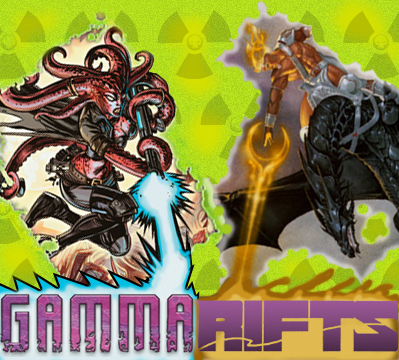 Note: For this blog entry I’m assuming the reader has familiarity with the Rifts setting, because, well, you wouldn’t really be interested in using it for your Gamma World Game if you didn’t.
Note: For this blog entry I’m assuming the reader has familiarity with the Rifts setting, because, well, you wouldn’t really be interested in using it for your Gamma World Game if you didn’t.
Last week I mentioned my desire to run a Gamma World game within the setting of Rifts. I’ve thought more about it and I definitely think it can be done with very little modification. I like the setting of the Gamma World game itself, its fun and I especially love the weird interpretations those on Gamma Terra have about the culture (and naming conventions) of the ‘ancients’ (us). But a ‘kitchen sink’ setting like Rifts offers a few advantages, the most important being the easy (and expected) importation of all the cool magical monsters from D&D. On the other side of things, I get to keep a setting I love while ditching a rule set I’ve come to loathe. I’m not the first to do this. Converting Rifts to other game systems is something of an internet wide pastime (which, in my opinion is a good barometer of how great a setting it is and how problematic the rules are). Of the blogs I follow there’s BTR (that’s better than rifts), Outsyder’s Spectrum Shock, the 4e Rifts Earth Saga, heck even Ryan Dancey (the father of open gaming) is on record saying that Rifts needed a d20 version (and that’s just the tip of the iceberg). There is such a demand that the forum at Palladium books even has a section detailing why they won’t allow Rifts to be converted to any other system (I’m just going to assume Palladium has enough problems of its own to care what I’m doing in the corner over here).
Characters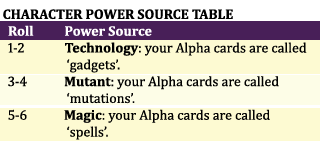
So how to make it work using Gamma World? The best attempt I’ve seen is here, and it takes the approach of creating new character origins based off of the Rifts O.C.C.s and R.C.C.s (juicers, power armor pilots, mind melters, etc.). The origins are good and it does a great job of directly translating the source material, but that’s not what I think is needed. In Gamma World, the more origins the better (that way there’s less of a chance of duplication within the party), so any approach that limits them to a static set I think is missing out on one of the appealing things about the game (plus it looks like each Gamma World supplement is going to add to the list). Instead, my solution is to have characters add another level of detail, layered on top of their origins, that filters their powers into something that would better fit in the world of Rifts. After all, the character creation process in Gamma World is all about interpreting how those origins interact with one another, the power source just guides that interpretation in a Rifts direction.
Using the table, characters can roll or choose a power source. Each power source gives a label to the character’s powers (Alpha mutation cards). So for example: an Electrokinetic Yeti with the technology power source could be a bionic Dog-boy with a built in neural mace attached to its arm; a Radioactive Gravity Controller with the magic power source could be a Ley-line Walker with ominous glowing eyes, always floating a few inches off the ground; and a Speedster Hypercognitive with the technology power source would be a perfect Juicer.
To continue the example: a bionic Dog-boy with the hostility Alpha card has learned how to short-circuit his neural mace to override a target’s cognition; a Ley-line Walker with the stoke resentment Alpha card casts the ‘wisps of confusion’ spell; and a Juicer with the venomous spurs Alpha card draws a poisoned switchblade (why are these powers always changing? That’s explained in the altered Rifts fluff at the end of the article).
Allowing for broad interpretations fits Gamma World better and I think allows for the kind of infinite possibilities necessary to recreate the tremendous variety of O.C.C.s and R.C.C.s in the Rifts game.
Other Rules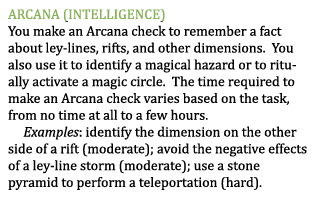
Add Arcana to the skill list (it screws up the symmetry of the skill list, but nothing’s perfect). When importing creatures from D&D add appropriate keywords: dragons, demons, elementals, undead, and goblins make great extradimensional monsters; grell, kruthik, mind flayers, and oozes make great extraterrestrial monsters; carrion crawlers, displacer beasts, owlbear, shambling mounds, and spiders make great terrestrial monsters. Finally add some magically oriented Omega Tech cards (these templates make it easy), like the TK -Machine gun, Cloak of Invisibility, Rune Weapons, and Symbiotes.
The World
A subtle change to the Rifts fluff brings the two games a little closer in line with one another:
“In the ages of the ancients, humanity lived in a golden age of prosperity. It was a time of high technology, human augmentation and fusion powered travel. Sages don’t agree on the causes of the ‘Big Mistake’ that awakened the rifts and brought down the apocalypse. Was it a global war of pride between the kingdoms of the ancients that snuffed out a billion souls whose backlash of psychic energy was too much for the earth’s ley lines to bear? Were the ancients being punished for ignoring the warning of their prophets that the stars would align for the return of the children of the Old Ones? Perhaps it was the hubris of ancient scientists at fabled ‘project arrowhead’ attempting to open a doorway to another world? Perhaps all are true.
Regardless of the cause, the results of the Big Mistake are plain for all to see. Ley lines, pathways of psychic energy that crisscrossed the planet, crackled with overflowing energy. Where these lines intersected the power was so great that rifts to other dimensions were torn through the fabric of space. Magic, once thought to be superstition and sleight of hand, became a powerful force in the world as real as science. Alien intelligences, demons, and creatures from nightmare poured through the rifts to invade our world. Atlantis rose from the ocean, unleashing biblical tsunamis on the world’s coastlines. Civilization ended almost overnight, but not before the ancients unleashed their most powerful weapons of mass destruction.
That was a hundred years ago. The Americas are a wasteland dotted with settlements carved out of the junk of the ancients. People use whatever they can to survive, be it scraps of technology, magical incantation or newfound mutant ability. But nothing is certain in this post apocalyptic age. The chaotic energy of the ley lines affects all things. Guns might stop working just as a machine that’s been dead for years lurches to life. Spells carved into millennia old tablets have random and unpredictable results. Mutants, their DNA forever altered by exposure to radiation and magic spontaneously grow wings and breathe fire.
It is a harsh world we have inherited from the ancients. One filled with monsters and uncertainty.” – from the History of the Wasteland, 101 P.A.
Random Encounters: Powered Armor of the Barrier Peaks
December 24, 2010 Synchronicity (not just a great song by the Police, it’s also the most powerful weapon in Robotech) is to thank (/blame) for this post. Right around the time I read this D&D Alumni article about using the new Gamma World game to convert the classic module Expedition to the Barrier Peaks to 4e, I was exposed to the gonzo magnum opus, Booty and the Beast, over on Mr. Lizard’s gaming site. I was inspired.
Synchronicity (not just a great song by the Police, it’s also the most powerful weapon in Robotech) is to thank (/blame) for this post. Right around the time I read this D&D Alumni article about using the new Gamma World game to convert the classic module Expedition to the Barrier Peaks to 4e, I was exposed to the gonzo magnum opus, Booty and the Beast, over on Mr. Lizard’s gaming site. I was inspired.
It’s no coincidence (eh, synchronicity), that these two things should gel in my mind. Old School idol Erol Otus did the art for both products and both feature technological gadgets and weapons to incorporate into your fantasy rpg. The art and the crazy ideas in these two products are inspiring. It reminds me of a time when my mind was more open and new ideas were as easy as flipping open a comic, or turning on the TV and adding a few more ingredients to the mental stew. Sometimes it worked, sometimes it didn’t, but I was never afraid to try. Then I became a lot more serious about rpgs.
I have a confession. As cool as I thought it was (and I even owned a used 1e copy of Gamma World), I’ve never played Expedition. There’s a reason. When I was learning the ropes of DMing in public school, if I saw something I liked in one of the books, my players would find it (which led to the party’s ranger carrying a brace of magic short swords including a luck blade, nine-lives stealer, frostbrand, and more). While this was its own kind of fun, as I got older it started to lose its luster and I tried very hard at being a more serious DM. For me, when the players got their hands on machine guns and rocket launchers (putting the rpg in rpg) it was a sign that the game had gone to crazy town and the campaign was about to implode. So as much as, ‘it’s the adventure where you get to fight robots and pick up lasers’, appealed to me, it also had a giant blinking warning sign above it. Dungeons and Dragons was a tightly controlled universe that didn’t need game breaking technology floating around for the players to trip over (in high school I had a reputation as being pretty stingy with magic items). But there’s a part of me that’s very attracted to genre crossing (probably influenced by Marvel comics’ approach), which is probably why I found Rifts so refreshing in the 2e days (my love affair with Palladium is fodder for another post).
Skip ahead many years (too many) to the present. My head full of Otus Galactic Dragons and Bart Carroll issues the challenge to stat up the powered armor from Expedition. Now, I don’t own the new Gamma World, so I don’t know what an ‘omega tech’ card is, but I wanted to see if I was able to make a version of the armor that could be brought into a 4e game without destroying it. I decided to make it an artifact, since it appealed to the DM in me (artifacts are unique, easily controlled by the DM and are only in the game a limited time) and I thought the concordance mechanic was a good abstraction of the players trying to figure the thing out.
I’ve rambled on far enough without any goods to show for it, so without further ado I give you the powered armor of the Barrier Peaks.
The Powered Armor of the Barrier Peaks
Powered armor of the Barrier Peaks is appropriate for characters in the middle of the paragon tier and upward.
Goals of Powered Armor
• This artifact is not sentient and so has no goals of its own.
Roleplaying Powered Armor of the Barrier Peaks
Powered armor of the Barrier Peaks is different than other artifacts. It cannot communicate with its wearer and has no specific agenda it was created to pursue. It is the product of a foreign science even the most powerful archmagi find impossible to understand. Mastery of the item comes through experimentation and tinkering. Damaging the armor and allowing its power source to run unchecked will lead to the ruin, not just of the armor’s owner, but of everything around her.
Powered Armor of the Barrier Peaks Lore
History DC 20: Legend holds that the infamous steel clad dungeons of the Barrier Peaks were formed when the comet Warden crashed into the mountains decades ago. The winding passages of these mysterious halls are filled with exotic treasures and dangerous creatures seen no where else in the world. Perhaps the greatest treasure of all is the fabled suit of powered armor that is said to lie here, buried with the remains of the advanced race that built it.
History DC 25: Sages speculate that the alien magic used to create the powered armor of the Barrier Peaks is the same that drove the warlord Lum insane in his quest to build the gargantuan machine that bears his name.
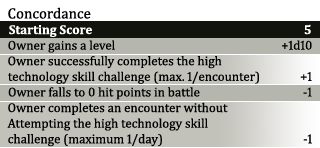
Pleased (16-20)
“Your spells are quaint superstitions next to the technological might of super-science.”
The armor’s enhancement bonus increases to +5.
Power (Daily): Fusion Blast. Standard Action. Close burst 5 (enemies in burst); Constitution vs. Reflex; Hit: 4d6 + Constitution modifier fire and force damage and ongoing 5 fire damage.
Satisfied (12-15)
“The secrets of this strange magic begin to open up to me.”
Power (Daily): Force Field. Immediate Interrupt. You can use this power when you are hit by an attack that causes damage. You gain resist all 10 + Constitution modifier until the end of your next turn.
Normal (5-11)
“I sense great power here fore those with the wisdom to use it… and great danger for the ignorant.”
The wearer is just beginning to understand the armor’s potential. Careful testing of its capabilities in combat will unlock greater functions.
Unsatisfied (1-4)
“I know I can figure this thing out. I just need more time.”
The wearer has taken the armor for granted, using its capabilities without bothering to try and understand its systems. Overloads and malfunctions are becoming more commonplace.
The armor’s enhancement bonus drops to +3.
Special: The first time each day a critical hit is scored against you, you suffer ongoing 10 lightning damage (save ends). Aftereffect: you are weakened (save ends).
Angered (0 or lower)
“What does this button do?”
The armor is severely damaged and it is only a matter of time before a 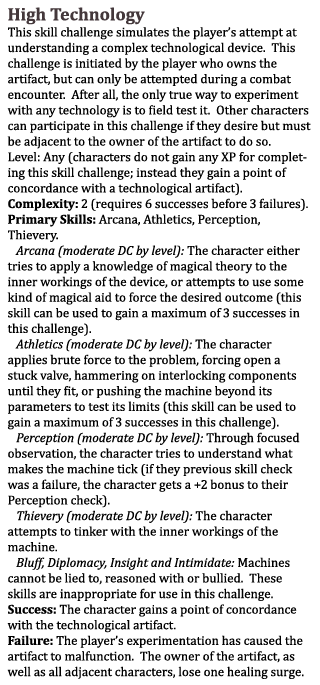 complete critical systems failure.
complete critical systems failure.
The armor’s enhancement bonus drops to +2.
Special: The first time each day you score a critical hit make the following attack as a free action: critical malfunction; close burst 4 (allies in burst); Constitution vs. Reflex; Hit: 4d6 + Constitution modifier fire and force damage.
Moving On
“The flux capacitor is completely drained.”
All machines eventually break down, burn out, or run out of fuel. Even a fusion powered suit of armor. How and when the armor moves on depends on how well the artifact’s owner can control it.
When the powered armor of the Barrier Peaks reaches its limit, if it is at least satisfied, the owner is able to power it down during a non-critical time (during an extended rest, for instance) and avoid any catastrophes. In addition, time spent breathing the nanite filtered air has had beneficial side effects. The owner gains a permanent +2 bonus on Endurance checks, and can re-roll (keeping the higher roll) any failed Endurance check made to avoid suffocation or drowning damage.
An unsatisfied or angered suit of armor goes into critical meltdown at the most inopportune time. The armor explodes and makes the following attack (which includes the owner), close burst 5 (all creatures in burst); +20 vs. Reflex; Hit: 3d10+6 fire and force damage, and the target is knocked prone; Miss: half damage.
Notes:
I wanted to use a skill challenge to increase concordance because I felt it nicely replicated the complex flow charts that Expedition used to ‘simulate ignorance’ in the proper use of technological items. Players could experiment with these items during downtime, but the charts had some dangerous outcomes so there was real risk involved (losing charges, getting hurt or the item blowing up). Since my version of this item was an artifact and didn’t have charges, and given how healing and extended rests worked in 4e, that meant I would need to tweak things in order to preserve that element of danger. I felt a simple solution would be to make a skill challenge that could only be undertaken during a combat encounter. That way, if the players want to increase their understanding of the armor they have to be willing to sacrifice some of their combat actions (not to mention potentially losing a healing surge).
The picture is a twenty-one gun (or maser) salute to Erol Otus’ illustration of the power armor in Expedition. Somehow the 1970’s science fiction imagery of power armor just seems to fit D&D better than the anime aesthetic (although I do picture Gigantor as the mighty servant of Leuk-O).
